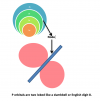Links of TOK with Chemical Equilibrium :Discover the interesting connections between Chemistry and TOK! This post explores the relationship between chemical equilibrium and Theory of Knowledge and provides valuable insights into both fields.
Chemical equilibrium is a fascinating concept that bridges the gap between Chemistry and Theory of Knowledge (TOK). This post dives into the relationship between chemical equilibrium and TOK, exploring their linkages and uncovering valuable connections.
What is Chemical Equilibrium?
Chemical equilibrium is an important concept in Chemistry that refers to the dynamic balance between reactants and products in a chemical reaction. This occurs when the forward and backward rates of the chemical reaction are equal, creating an equilibrium between the two states. It’s important to understand that equilibrium is not a stable state – when external influences like temperature or concentration of reactants change, the ratio between reactants and products will also change. As such, chemical equilibrium is a dynamic process that must be monitored in order to accurately determine changes in reaction rates.
Different Views on Chemical Reactions from TOK Perspectives.
Through the lens of Theory of Knowledge (TOK), we can explore the concept of chemical equilibrium in further detail. Different perspectives such as reason, imagination, faith and personal knowledge might be used to shape our understanding of how a reaction occurs and changes over time. For example, reason may shed light on why certain reactants form products in a specific ratio; imagination may help us envision what this process looks like when it’s happening; faith could inform our beliefs about the stability or instability of an equilibrium state; and personal knowledge could act as a guide in determining when other external influences are affecting the system.
How Does TOK Explain Chemical Equilibrium?
To understand TOK’s relationship to chemical equilibrium, it helps to consider the different points of view that can be applied to any system. Each perspective – reasoned argument, imaginative musing, faith-based insight and personal knowledge – can offer a valid interpretation of the same phenomenon. By using these perspectives together, we can gain an understanding of the equilibrium states found in chemical reactions and how they may react to external forces.
Examples of Chemical Equilibrium in Real Life Situations.
Chemical equilibrium can be found in everyday life thus Links of TOK with Chemical Equilibrium, particularly in situations involving a balance between opposing forces. Consider the competition between two professional soccer teams: each coach and player is seeking victory, but their efforts will likely lead to an overall equilibrium point of neither team emerging as a clear victor. By studying such interactions, we gain valuable insights into the process of how competing forces can come together to create a balanced state.
Potential Implications for the Theory of Knowledge and Chemistry Fields.
Analyzing the similarities between Chemical Equilibrium and TOK could have significant implications for both fields. By studying equilibrium and looking for opportunities to bridge the gap between competing forces, we can gain a better understanding of how ‘competitive tension’ affects knowledge production. Additionally, by observing chemical equilibrium in action and noting the interconnectedness between competing elements, students can learn to recognize the relevance of chemistry in everyday life, as well as its potential connections to other fields such as psychology, economics and sociology.

